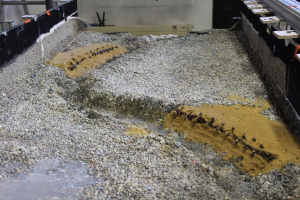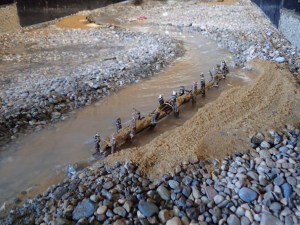In order to better understand these mechanical strength functions of the structures, IRSTEA researchers (hydraulic engineers and ecologists) are testing the different behaviours of fascines on a physical model in the laboratory (hydraulic canal including bank protection work).

View of the canal with the riverbed and two fascines on sand before simulating the flood. © André Evette.
One of the objectives is to understand the mechanisms of dislocation and more particularly the role of transporting solids (recent work on wattle fencing has confirmed that this component plays a key role in the maintenance of riverbanks, especially for current floods). Analytical metrics have been identified (hydraulic constraints or power, solid flow as part of morphogenetic flow or flood, sedimentary forms and associated wavelengths, dimensionless quantities associating granulometry, slope and geometry of the bed, etc). The integration of living plants into the reduced model requires the joint presence of hydraulic engineers and biologists and gives an intrinsically interdisciplinary dimension to the experiment.


